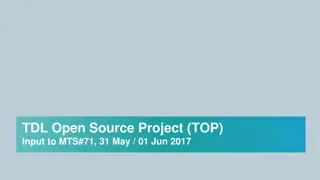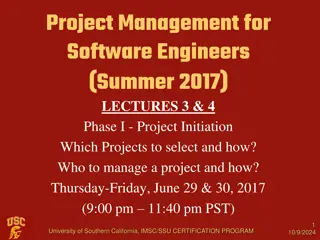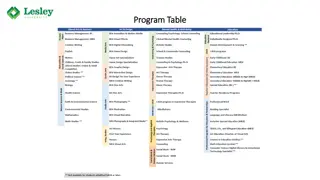Understanding Project Management Essentials in Academic Setting
Explore the fundamental concepts of project management as defined by Dr. S. Bellarmin Diana, an Assistant Professor at Bon Secours College for Women in Thanjavur. Learn about the nature of projects, their characteristics, definitions, and classifications, providing a comprehensive overview for students and professionals alike.
Download Presentation

Please find below an Image/Link to download the presentation.
The content on the website is provided AS IS for your information and personal use only. It may not be sold, licensed, or shared on other websites without obtaining consent from the author. Download presentation by click this link. If you encounter any issues during the download, it is possible that the publisher has removed the file from their server.
E N D
Presentation Transcript
PROJECT MANAGEMENT PROJECT MANAGEMENT Dr.S.BELLARMIN DIANA ASSISTANT PROFESSOR PG & RESEARCH DEPARTMENT OF MANAGEMENT STUDIES BON SECOURS COLLEGE FOR WOMEN, THANJAVUR
INTRODUCTION TO PROJECT INTRODUCTION TO PROJECT In common parlance, the word project has been used to connote any program of action . Exmple: agricultural projects, illiteracy eradication project,land development project and so on. Project is an idea or a plan that is intended to be carried out in the future or that is being carried at preset.
DEFINITION DEFINITION A project is any scheme or a part of a scheme for investing resources, which can be reasonably analyzed and evaluated as an independent unit. It may be any item of investment activity,which can separately be evaluated -Little and Mirless A project is the whole complex of activities involved in using resources to gain benefits -Gittinger A project is an economic activity with well defined objectives and having specific beginning and end. -Vasant Desai
Characteristics of a Project Characteristics of a Project The project is essentially an investment plan The project begins with precise and clear objectives The project determines the direction of future actions of an entrepreneur It outlines the allocation of resources
Characteristics of a Project Characteristics of a Project The project has a specific geographic location The scientific and reasonable analysis and appraisal is done in the project with respect to financial and technical aspects. The project has specific beginning and terminating points Commercial viability is the soul of the project
PROJECT CLASSIFICATION PROJECT CLASSIFICATION Project classification Little and Mirrles s classification Sector- wise classification Techno-economic classification Other classification
PROJECT CLASSIFICATION PROJECT CLASSIFICATION Little and Mirrles s classification Quantifiable projects Non-quantifiable projects
PROJECT CLASSIFICATION PROJECT CLASSIFICATION Agriculture and Allied Sector Miscellaneous Sector Irrigation and Power Sector Sector-wise classification Industry and Mining Sector Social Services Sector Transport and Communication Sector
PROJECT CLASSIFICATION PROJECT CLASSIFICATION
PROJECT CLASSIFICATION PROJECT CLASSIFICATION
PROJECT IDENTIFICATION MEANING Project identification means a process of finding out the most appropriate project from among the several investment opportunities According to Dr. Vasant Desai the project identification is concerned with the collection, compilation and analysis of economic data for the eventual purpose of locating possible opportunities for investment.
SOURCES OF PROJECT IDEA SOURCES OF PROJECT IDEA
STEPS IN PROJECT IDENTIFICATION STEPS IN PROJECT IDENTIFICATION Conceiving project ideas Choosing the right line of business STEPS IN PROJECT IDENTIFICATION Decision- making process Opportunity seeking
Conceiving project ideas Conceiving project ideas Conceiving the project idea is mental process Supported by certain virtues like curiosity, initiative,vision and courage. The project idea could emerge from one or more of the following sources. a. Success stories of friends, relatives and other entrepreneurs. b. Increasing demand for certain products in home market and foreign markets where price advantage could be obtained. c. Experience of others in manufacture or sale of a product d. Chances of producing a substitute of an article imported for which there is a good demand in home country.
Conceiving project ideas Conceiving project ideas The project idea could emerge from one or more of the following sources. e. Visit to trade fairs and exhibitions f. Study on demand supply imbalance g. Government s industrial, import-export policies and the policies for development of backward area h. Survey reports, books, periodicals, news papers
Choosing the right line of business Choosing the right line of business The second important step in project identification is choosing the right line of business. To ensure the success of business, the prospective entrepreneur has to spend considerable time and energy on choosing the right line of activities. While doing so he has to examine the business potential of his ideas
Opportunity seeking An entrepreneur is basically an opportunity seeker. A number business opportunities may be available, however, seeking the right business opportunity depends upon the entrepreneur s capabilities, his strengths and weaknesses and also on his preferences. Identification of appropriate business opportunity requires specialized skills. Before coming to the final decision,he has to explore and analyze all possible opportunities.
Decision making process This final step in project identification involves making important decisions regarding the project to be undertaken. While taking decisions, the prospective entrepreneur has to go through following steps. Selection of broad industry group Selection of specific project Final decision
THANK YOU THANK YOU























